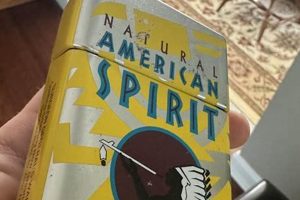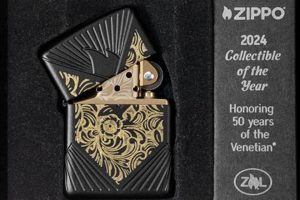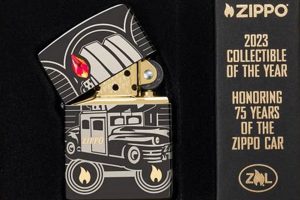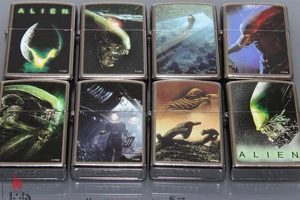Pocket lighters manufactured by Zippo Manufacturing Company, characterized by their windproof design and distinctive “click,” have transcended their utilitarian purpose to become sought-after items for enthusiasts and collectors. Limited editions, unique engravings, and historical significance contribute to their desirability. For example, a lighter commemorating a specific historical event or bearing the artwork of a renowned artist can hold substantial value.
The enduring appeal of these iconic lighters stems from factors beyond mere functionality. They represent a piece of Americana, embodying craftsmanship, durability, and a nostalgic connection to past eras. Furthermore, the robust construction and lifetime guarantee contribute to their longevity, making them potential heirloom pieces passed down through generations. Building a collection can be a rewarding hobby, offering opportunities to connect with other enthusiasts and delve into the rich history and diverse designs available.
This exploration will delve further into specific aspects of collecting these iconic pieces, covering topics such as identifying rare and valuable models, proper storage and preservation techniques, and resources for connecting with the wider collecting community. It will also examine the evolution of designs and manufacturing processes throughout the company’s history.
Tips for Collecting Zippo Lighters
Building a meaningful collection requires careful consideration and informed decisions. The following tips offer guidance for navigating the diverse world of these iconic lighters.
Tip 1: Focus on a Niche: Rather than attempting to acquire every lighter available, concentrating on a specific theme, era, or design element (e.g., military insignia, advertising, or a specific decade) can lead to a more curated and valuable collection.
Tip 2: Authenticate Before Purchasing: Counterfeit lighters exist. Examine the bottom stamp for date codes and other markings consistent with genuine products. Consulting reputable dealers and online resources can help avoid costly mistakes.
Tip 3: Consider Condition: Mint condition lighters generally command higher prices, but well-preserved examples with minor wear can also be desirable. Assess the lighter’s finish, hinge, and insert for signs of damage or excessive use.
Tip 4: Proper Storage is Crucial: Store lighters in a cool, dry environment away from direct sunlight. Avoid storing them filled with fuel for extended periods to prevent evaporation and potential damage to the seals.
Tip 5: Research and Learn: Utilize online resources, books, and collector forums to gain knowledge about different models, their history, and their estimated values. This information is essential for making informed purchasing decisions.
Tip 6: Network with Other Collectors: Joining online communities and attending collector events provides opportunities to share knowledge, discover rare finds, and potentially trade or purchase lighters.
Tip 7: Document Your Collection: Maintain a detailed inventory of your lighters, including their model, date, condition, and provenance. Photographs and accompanying documentation can enhance the value and historical significance of the collection.
By following these guidelines, enthusiasts can cultivate a collection that is both personally rewarding and potentially valuable. Careful research, authentication, and proper storage are key elements for building a successful and enduring collection.
This advice provides a foundation for embarking on a fulfilling collecting journey. The subsequent conclusion will summarize the key takeaways and offer further resources for continued exploration within the realm of these enduringly popular lighters.
1. Rarity
Rarity stands as a cornerstone of collectibility, significantly influencing the desirability and value of Zippo lighters. Scarcity drives demand within the collecting community, transforming specific models into coveted treasures.
- Limited Production Runs
Certain Zippo lighters were manufactured in limited quantities, either to commemorate specific events or as special releases. These restricted production numbers inherently create scarcity. For example, lighters produced for specific corporate anniversaries or those released during short-lived advertising campaigns often become highly collectible due to their limited availability.
- Discontinued Models
Zippo has introduced and discontinued various models throughout its history. Once a model ceases production, the existing supply becomes finite, increasing its rarity over time. Examples include specific case designs, finishes, or insert mechanisms that are no longer manufactured. These discontinued models often gain significant value as collectors seek to acquire these pieces of Zippo history.
- Unique or Custom Designs
Lighters featuring unique engravings, artwork, or custom designs contribute to rarity. These one-of-a-kind pieces, often commissioned by individuals or organizations, stand apart from mass-produced models. Examples include lighters engraved with personal names, company logos, or intricate artistic designs. Such unique attributes increase their desirability among collectors.
- Historical Significance
Lighters associated with historical events or periods can become rare and highly sought after. Examples include wartime production lighters or those commemorating significant milestones. The historical context adds to their collectible value. Lighters carried by soldiers during specific conflicts, or those commemorating historical events, gain value due to their connection to the past.
These facets of rarity intertwine to create a hierarchy of desirability within the Zippo collecting community. The scarcer a lighter, the more desirable it becomes, driving demand and ultimately increasing its value. This pursuit of rarity fuels the passion of collectors and shapes the dynamics of the Zippo collecting market.
2. Condition
Condition significantly impacts the value and collectibility of Zippo lighters. A lighter’s state of preservation directly correlates with its desirability among enthusiasts. Factors influencing condition include wear and tear from use, the presence of scratches or dents, the functionality of the hinge and flint wheel, and the preservation of the original finish. For example, a lighter exhibiting minimal wear, retaining its original factory finish, and functioning flawlessly commands a premium compared to a heavily used lighter with scratches, dents, and a tarnished finish. Even seemingly minor imperfections can significantly impact a lighter’s value, particularly for rare or sought-after models.
Collectors often categorize lighter condition using terms like “mint,” “near mint,” “excellent,” “very good,” and so on. These classifications provide a standardized framework for assessing and describing a lighter’s state of preservation. While a “mint” condition lighter, often unused and retaining its original packaging, represents the pinnacle of collectibility, well-preserved examples demonstrating careful handling and minimal wear also hold substantial value. The presence of original boxes and accompanying paperwork further enhances desirability, as it demonstrates provenance and careful ownership throughout the lighter’s history.
Understanding the nuances of condition assessment is crucial for collectors. Careful examination, including scrutinizing the lighter’s surface for imperfections, testing the hinge and flint wheel mechanism, and evaluating the integrity of the finish, allows for accurate appraisal. This knowledge enables informed purchasing decisions and facilitates realistic pricing within the collecting community. The impact of condition underscores the importance of proper storage and handling to preserve a lighter’s value and ensure its long-term collectibility.
3. Historical Significance
Historical significance plays a crucial role in the collectibility of Zippo lighters, adding layers of value beyond mere aesthetics or rarity. Specific historical associations can dramatically increase a lighter’s desirability and worth. These connections often manifest through wartime production, commemorative editions, and association with significant individuals or events.
Wartime production significantly impacts a lighter’s historical value. Lighters carried by soldiers during World War II, the Korean War, or the Vietnam War often bear unique markings, military insignia, or personal engravings, offering glimpses into these conflicts. These artifacts provide tangible connections to historical events, making them highly sought after by collectors and military history enthusiasts. For instance, a Zippo lighter carried during the D-Day landings or discovered in a battlefield trench possesses inherent historical value due to its direct link to pivotal moments in history.
Commemorative editions also contribute to historical significance. Zippo has released numerous lighters commemorating historical events, anniversaries, or significant figures. These editions often feature special engravings, artwork, or unique case designs reflecting the commemorated subject. For example, lighters celebrating presidential inaugurations, historical anniversaries, or significant cultural milestones become collectible items due to their association with these events. The commemorative nature imbues these lighters with a historical narrative, increasing their appeal to collectors.
Furthermore, association with significant individuals or events can elevate a lighter’s historical significance. Lighters owned or used by prominent figures, such as political leaders, military commanders, or celebrities, can become highly collectible. Provenance and documented ownership history play a vital role in establishing authenticity and value in such cases. A lighter with a documented history of ownership by a historical figure becomes a tangible piece of that individual’s legacy, further enhancing its collectibility.
Understanding the historical context surrounding a Zippo lighter is essential for collectors. Researching a lighter’s production date, any associated markings or engravings, and its potential connection to historical events can provide valuable insights into its significance and potential value. This understanding allows collectors to appreciate the historical narrative embedded within these seemingly simple objects, transforming them from mere lighters into tangible pieces of history. The historical significance of a Zippo lighter often becomes the defining factor in its desirability and value within the collecting community.
4. Unique Designs
Unique designs represent a significant factor driving the collectibility of Zippo lighters. Beyond standard production models, a vast array of unique designs elevates these lighters into personalized expressions of artistry, commemoration, and corporate branding. These designs significantly enhance their appeal to collectors, transforming utilitarian objects into miniature canvases showcasing diverse artistic styles, historical references, and corporate identities.
- Artistic Engravings
Intricate engravings transform Zippo lighters into miniature works of art. Skilled artisans employ various techniques to etch detailed designs onto the lighter’s surface, ranging from simple monograms to complex landscapes, portraits, and wildlife scenes. These artistic engravings personalize the lighter, often reflecting the owner’s interests or commemorating special occasions. The level of detail and craftsmanship significantly impacts a lighter’s value within the collecting community. For instance, a lighter featuring a meticulously engraved depiction of a historical landmark or a finely detailed portrait holds greater value than a lighter with a simpler, less intricate design.
- Commemorative Themes
Commemorative themes frequently adorn Zippo lighters, marking special events, anniversaries, or historical milestones. These designs often incorporate specific dates, logos, or imagery related to the commemorated event. Limited edition releases celebrating historical anniversaries, corporate milestones, or popular culture events become highly collectible. For example, a lighter commemorating the anniversary of a historical event or a limited edition release celebrating a popular film franchise holds significant appeal for collectors interested in these specific themes. The commemorative nature imbues these lighters with added value and desirability.
- Corporate Branding and Advertising
Zippo lighters have served as effective advertising mediums for decades. Companies often commission custom lighters featuring their logos, slogans, or product imagery. These corporate-branded lighters serve as promotional items, corporate gifts, or collectibles for enthusiasts. Vintage advertising lighters from well-known brands, especially those from iconic companies or discontinued products, become highly sought after by collectors. For example, a vintage lighter advertising a classic automobile or a discontinued beverage brand holds significant appeal for collectors interested in advertising memorabilia or specific product lines. The historical and nostalgic value of these lighters contributes to their collectibility.
- Personalization
Personalized designs transform Zippo lighters into unique, individual expressions. Custom engravings, initials, names, or special dates add a personal touch, making the lighter a treasured keepsake or a personalized gift. Lighters engraved with personal messages, military insignia, or commemorative dates become cherished possessions. The personal connection associated with these lighters enhances their sentimental value, making them less likely to be traded or sold within the collecting community. While their monetary value might not always surpass rarer models, their personal significance makes them invaluable to their owners.
These diverse design elements significantly contribute to the collectibility of Zippo lighters. The unique designs transform functional objects into personalized expressions of artistry, commemoration, and brand identity. Whether it’s an intricately engraved artwork, a commemorative edition celebrating a historical event, a vintage advertising piece, or a personally engraved keepsake, these unique designs elevate Zippo lighters beyond mere utility, adding layers of meaning and value that resonate with collectors. The pursuit of unique and personalized designs fuels the passion within the Zippo collecting community, driving demand and shaping the market for these miniature canvases of creativity and historical significance.
5. Limited Editions
Limited edition releases represent a significant driving force within the collectible Zippo lighter market. The inherent scarcity created by limited production runs significantly enhances desirability and value. These releases often commemorate specific events, anniversaries, or collaborations, imbuing them with a sense of exclusivity and historical significance that resonates with collectors.
- Numbered Editions
Many limited edition Zippo lighters feature individual numbering, indicating their place within the production run. This numbering system clearly defines the scarcity of each piece, increasing its value and appeal to collectors. A lower number, especially a single-digit or low double-digit number, often commands a premium within the collecting community. For example, a lighter numbered “007/1000” holds greater value than one numbered “999/1000” due to its perceived rarity.
- Commemorative Releases
Limited edition releases frequently commemorate historical events, anniversaries, or significant milestones. These releases often incorporate unique engravings, artwork, or case designs reflecting the commemorated subject. Examples include lighters commemorating historical anniversaries, significant birthdays of iconic figures, or important events in popular culture. These commemorative releases appeal to collectors interested in the specific event or subject, adding a layer of historical significance to the collectible lighter. For example, a limited edition lighter commemorating the 50th anniversary of the moon landing would hold particular appeal to space exploration enthusiasts.
- Collaborative Editions
Zippo frequently collaborates with artists, brands, and organizations to produce limited edition lighters. These collaborations often feature unique artwork, designs, or branding elements specific to the collaborating entity. Collaborations with renowned artists, popular musicians, or iconic brands generate significant interest among collectors. The combined appeal of the Zippo brand and the collaborating entity enhances the lighter’s desirability. For instance, a limited edition Zippo designed by a famous graffiti artist or featuring the logo of a legendary rock band would be highly sought after by collectors interested in these respective fields. These collaborations create a synergy that elevates the collectible value of the lighter.
- Special Finishes and Materials
Limited edition Zippo lighters often utilize special finishes or materials not found in standard production models. These might include rare metals, unique plating techniques, or intricate inlays. The use of premium materials like sterling silver, gold plating, or exotic wood inlays significantly elevates the lighter’s perceived value and adds a touch of luxury. For example, a limited edition lighter crafted from solid brass or featuring a rare cloisonn enamel finish would appeal to collectors seeking unique and high-quality pieces. The use of special materials and finishes enhances the lighter’s aesthetic appeal and contributes to its exclusivity within the collecting community.
The combination of scarcity, commemorative themes, unique designs, and collaborative partnerships elevates limited edition Zippo lighters to a higher tier within the collecting world. These releases transcend mere utility, becoming coveted objects imbued with historical significance, artistic expression, and brand recognition. The pursuit of limited edition Zippo lighters fuels the passion within the collecting community, driving demand and contributing to the vibrant marketplace for these miniature, yet highly sought-after, pieces of functional art.
6. Authenticity Verification
Authenticity verification stands as a critical process within the realm of collectible Zippo lighters. Given their popularity and potential value, counterfeit lighters exist within the market. Discerning genuine Zippo lighters from counterfeits protects collectors from financial loss and ensures the integrity of their collections. Verification relies on careful examination of specific features and markings, demanding meticulous attention to detail and knowledge of genuine Zippo manufacturing characteristics.
- Bottom Stamp Examination
The bottom stamp of a Zippo lighter provides crucial information for authentication. Genuine Zippo lighters feature a specific stamping pattern, including the Zippo logo, a date code indicating the month and year of manufacture, and other markings designating the factory location. Variations in font, spacing, and depth of the stamping can indicate a counterfeit. Collectors often consult online resources and reference guides to compare bottom stamps and verify their authenticity against known genuine examples. Discrepancies in the bottom stamp serve as a primary indicator of a potential counterfeit.
- Case Construction and Materials
Authentic Zippo lighters exhibit specific construction characteristics and utilize specific materials. The weight, feel, and finish of the case can offer clues about authenticity. Counterfeit lighters may use inferior materials or deviate from the precise construction methods employed by Zippo. Examining the hinge, the lid fit, and the overall quality of the metal can help differentiate genuine lighters from counterfeits. Subtle variations in the case construction, such as inconsistencies in the metal thickness or the hinge mechanism, can indicate a non-genuine lighter.
- Insert Examination
The insert, the removable internal mechanism of a Zippo lighter, also provides clues for authentication. Genuine Zippo inserts feature specific markings and construction details. Examining the flint wheel, the chimney, and the wick assembly can help identify counterfeits. Variations in the insert’s construction or markings often indicate a non-genuine lighter. For example, a counterfeit insert may have a different flint wheel design or lack specific markings found on genuine Zippo inserts.
- Provenance and Documentation
Provenance, or the documented history of ownership, can play a significant role in authenticating a collectible Zippo lighter. Original boxes, accompanying paperwork, and documented sales records can help establish a lighter’s authenticity. While not always available, provenance provides valuable supporting evidence, especially for rare or historically significant lighters. A lighter with a documented history of ownership, including purchase receipts or previous auction records, adds a layer of authenticity and can increase its value.
Authenticity verification is a crucial aspect of collecting Zippo lighters. By carefully examining the bottom stamp, case construction, insert details, and any available provenance, collectors can protect themselves from acquiring counterfeit lighters. This process ensures the integrity and value of their collections, allowing them to focus on the historical significance, artistic merit, and unique designs that make these lighters enduringly collectible. The ability to discern genuine Zippo lighters from counterfeits empowers collectors to confidently navigate the market and build collections of genuine value and historical importance.
7. Proper Storage
Proper storage plays a crucial role in preserving the condition and value of collectible Zippo lighters. These lighters, often composed of brass or other metals, are susceptible to tarnish, corrosion, and other forms of degradation if not stored correctly. Environmental factors, such as humidity, temperature fluctuations, and exposure to sunlight, can accelerate these detrimental processes, diminishing a lighter’s aesthetic appeal and impacting its value. For instance, a lighter stored in a humid environment without proper protection might develop a layer of tarnish, obscuring its finish and diminishing its collectibility. Similarly, exposure to direct sunlight can fade painted finishes or cause discoloration over time.
Appropriate storage methods mitigate these risks. Storing lighters in a cool, dry environment away from direct sunlight inhibits the chemical reactions that lead to tarnish and corrosion. Utilizing airtight containers or specialized storage cases further protects against environmental factors, minimizing exposure to humidity and airborne contaminants. Furthermore, keeping lighters separate from one another prevents scratching and minimizes the risk of damage from accidental impacts. For example, storing a collection of lighters in individual compartments within a lined display case prevents them from rubbing against each other and causing surface scratches. Similarly, storing lighters in a dedicated cabinet or drawer, separate from other household items, reduces the risk of accidental damage.
Appropriate storage practices are essential for maintaining the long-term value and collectibility of Zippo lighters. Protecting these items from environmental damage and physical wear preserves their original condition, ensuring their continued appreciation by collectors. Neglecting proper storage can lead to irreversible damage, diminishing a lighter’s aesthetic and monetary value. Therefore, understanding and implementing effective storage strategies is crucial for preserving the integrity and historical significance of these collectible items. This careful approach safeguards their value and ensures their continued enjoyment for generations to come.
Frequently Asked Questions about Collectible Zippo Lighters
This section addresses common inquiries regarding collectible Zippo lighters, providing concise yet informative responses to facilitate a deeper understanding of this popular collecting niche.
Question 1: How can one determine the value of a collectible Zippo lighter?
Several factors influence a lighter’s value, including rarity, condition, historical significance, and unique designs. Consulting price guides, auction records, and reputable dealers can provide valuation insights. Online forums dedicated to Zippo collecting also offer platforms for discussing value and connecting with experienced collectors.
Question 2: What are the most sought-after Zippo lighters by collectors?
Rare or limited edition lighters, those with historical significance (e.g., wartime production or commemorative editions), and those featuring unique designs or artistic engravings generally command higher prices and greater interest among collectors.
Question 3: How can counterfeit Zippo lighters be identified?
Careful examination of the bottom stamp, case construction, and insert markings helps differentiate genuine Zippo lighters from counterfeits. Comparing these features against known authentic examples and consulting online resources aids in the identification process.
Question 4: What is the best way to store collectible Zippo lighters to preserve their condition?
Storing lighters in a cool, dry environment away from direct sunlight, preferably in airtight containers or specialized storage cases, protects them from tarnish, corrosion, and other environmental damage.
Question 5: Where can one purchase authentic collectible Zippo lighters?
Reputable dealers specializing in collectible lighters, online auction platforms, and dedicated Zippo collector forums offer avenues for acquiring authentic pieces. Verifying the seller’s reputation and carefully examining the lighter before purchase are essential precautions.
Question 6: Are Zippo lighters still produced today, and do modern releases hold collectible value?
Zippo Manufacturing Company continues to produce lighters, and certain modern releases, especially limited editions or those commemorating special events, can appreciate in value over time and become desirable collectibles.
Understanding these fundamental aspects of collecting Zippo lighters provides a foundation for building a meaningful collection. Thorough research, careful authentication, and appropriate storage practices are key components of responsible collecting, ensuring the long-term preservation and enjoyment of these iconic pieces.
Beyond these frequently asked questions, further exploration of specific collecting areas, such as wartime Zippos, commemorative editions, or unique artistic engravings, can enhance one’s appreciation for the depth and diversity within the world of collectible Zippo lighters. Subsequent sections will delve into these specialized areas, offering a more granular understanding of the nuances and complexities that contribute to the enduring appeal of these iconic lighters.
Collectible Zippo Lighters
This exploration has delved into the multifaceted world of collectible Zippo lighters, examining the factors that contribute to their desirability and value. From rarity and historical significance to unique designs and limited edition releases, the nuances of these iconic lighters extend far beyond their utilitarian function. Authenticity verification and proper storage emerged as critical considerations for preserving the integrity and value of any collection. The examination of wartime production, commemorative themes, artistic engravings, and corporate branding revealed the diverse influences that shape the collecting landscape. Understanding these key elements empowers informed collecting decisions, fostering an appreciation for the historical, artistic, and cultural significance embedded within these seemingly simple objects.
The enduring appeal of collectible Zippo lighters lies in their tangible connection to history, artistry, and personal expression. As these lighters continue to capture the interest of collectors worldwide, the ongoing pursuit of rare finds, unique designs, and historical artifacts ensures the vibrancy of this collecting niche for years to come. The meticulous attention to detail, the pursuit of authenticity, and the careful preservation of these miniature pieces of history define the essence of collecting Zippo lighters. Each lighter represents a tangible piece of the past, a miniature canvas of artistry, or a personalized expression of identity, reflecting the diverse passions and interests of collectors across generations. The journey of collecting these iconic lighters offers a continuous exploration of history, design, and the enduring allure of objects that transcend their utilitarian purpose.







